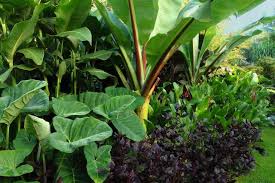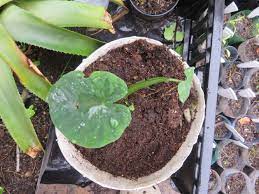Cocoyam shoots, also known as taro shoots or taro leaves, are the young, tender stems and leaves of the cocoyam plant (Colocasia esculenta). Cocoyam is a tropical root vegetable that is widely consumed in many parts of the world, particularly in Asia, Africa, and the Pacific islands.
The shoots and young leaves of the cocoyam plant are edible and are often used in culinary preparations. Cocoyam shoots are nutritious and rich in essential vitamins and minerals such as vitamin A, vitamin C, calcium, iron, and dietary fiber. They also contain protein and carbohydrates. Cocoyam shoots are used in various dishes, including stir-fries, soups, stews, salads, and curries. They have a slightly nutty flavor and a tender, slightly crisp texture.
Before using cocoyam shoots in cooking, they are usually washed thoroughly and then either boiled, steamed, or stir-fried to make them tender and ready for consumption. Consuming cocoyam shoots can be beneficial for health due to their nutritional content. They may contribute to a healthy diet, aiding in digestion, supporting the immune system, and providing essential vitamins and minerals.
Cocoyam is a staple food in many cultures and is often used in traditional dishes and celebrations. Harvesting cocoyam shoots in a sustainable manner is important to ensure the plant’s continued growth and production. Care should be taken not to over-harvest and damage the plant.
Always ensure that cocoyam shoots are properly cleaned and cooked before consumption to eliminate any potential health risks associated with raw consumption. Additionally, if you have specific dietary concerns or health conditions, it’s a good idea to consult with a healthcare professional before making significant changes to your diet.
The Economic Importance and Uses of Cocoyam Shoots

Cocoyam (Colocasia esculenta) shoots, also known as taro shoots or dasheen shoots, are young, tender shoots that sprout from the corms or bulbs of the cocoyam plant. These shoots hold economic importance and have various uses in both culinary and non-culinary domains.
Here are the economic importance and uses of cocoyam shoots:
1. Culinary Use: Cocoyam shoots are a valuable ingredient in many cuisines and traditional dishes in different parts of the world.
2. Cooking and Stir-frying: Cocoyam shoots can be stir-fried or cooked in various dishes, adding a unique flavor and texture to the meal.
3. Soups and Stews: Cocoyam shoots are commonly used in soups and stews to enhance flavor and nutritional value.
4. Salads: They can be used in salads to provide a crunchy texture and a mild, slightly nutty flavor.
5. Nutritional Value: Cocoyam shoots are a good source of essential nutrients, including vitamins, minerals, and dietary fiber. They are rich in vitamins A and C, as well as important minerals like calcium, iron, and potassium.
6. Dietary Supplement: Due to their nutritional content, cocoyam shoots can be utilized as a dietary supplement to boost the nutritional profile of meals and enhance overall dietary health.
7. Livestock Feed: Cocoyam shoots are also used as feed for livestock, providing a nutritious source of food for animals such as poultry, pigs, and cattle. The shoots can be used to supplement the diets of livestock, contributing to their growth and health.
8. Agricultural Practice: Cocoyam shoots can be utilized in agricultural practices for propagation. Farmers often use healthy, disease-free shoots for planting and establishing new cocoyam plants. This is crucial for expanding cocoyam cultivation and ensuring a steady supply of the crop.
9. Traditional Medicine: In some traditional medicine practices, cocoyam shoots are used for their potential health benefits. They may be used in remedies or treatments for various ailments, although scientific evidence regarding their medicinal properties is limited and requires further research.
10. Income Generation: The cultivation and sale of cocoyam shoots can generate income for farmers and traders. As a popular ingredient in local cuisines, there is a market demand for cocoyam shoots, providing economic opportunities for individuals involved in their production and distribution.
Read Also: Dates Drupe: Economic Importance, Uses and By-Products
11. Culinary Tourism: Cocoyam shoots contribute to the culinary diversity and cultural heritage of regions where they are commonly used. They can attract culinary tourism, drawing visitors interested in experiencing and tasting local dishes prepared with cocoyam shoots.
The Products and By-products That Can Be Derived From Cocoyam Shoots
Cocoyam, also known as taro or elephant ear, is a starchy root vegetable widely grown in tropical and subtropical regions. Various parts of the cocoyam plant, including the corms (underground bulbs) and shoots, can be used to derive a range of products and by-products.
Here’s a list and explanation of potential products and by-products from cocoyam shoots:
1. Fresh shoots: Cocoyam shoots can be consumed as a vegetable in various culinary dishes, such as soups, stews, stir-fries, salads, and side dishes.
2. Dried shoots: Cocoyam shoots can be dried and ground into a powder, which can be used as an ingredient in soups, stews, or mixed into flour for baking.
3. Fermented cocoyam shoots: Fermentation of cocoyam shoots can produce a variety of traditional dishes like “utazi” in Nigeria, where the shoots are fermented and used in soups.
4. Livestock feed: Cocoyam shoots can be used as animal feed, providing a source of nutrition for livestock like poultry and cattle.
5. Plant fertilizer: Cocoyam shoots can be composted and used as an organic fertilizer to improve soil fertility and enhance plant growth in agricultural settings.
6. Traditional medicine: In some traditional medicine practices, cocoyam shoots are used for their potential health benefits, including anti-inflammatory and anti-diabetic properties.
7. Biodegradable packaging materials: Cocoyam shoot fibers can be extracted and used to produce biodegradable packaging materials or products, contributing to environmentally friendly solutions.
8. Flavor enhancer: Extracts or infusions from cocoyam shoots may be used to enhance the flavor of certain dishes, sauces, or beverages.
In conclusion, cocoyam shoots have significant economic importance, primarily in the culinary industry, agriculture, livestock farming, and potential applications in traditional medicine. Their nutritional value and versatile culinary uses make them a valuable resource for both household consumption and commercial purposes.
Read Also: A Guide to Environmental Engineering

